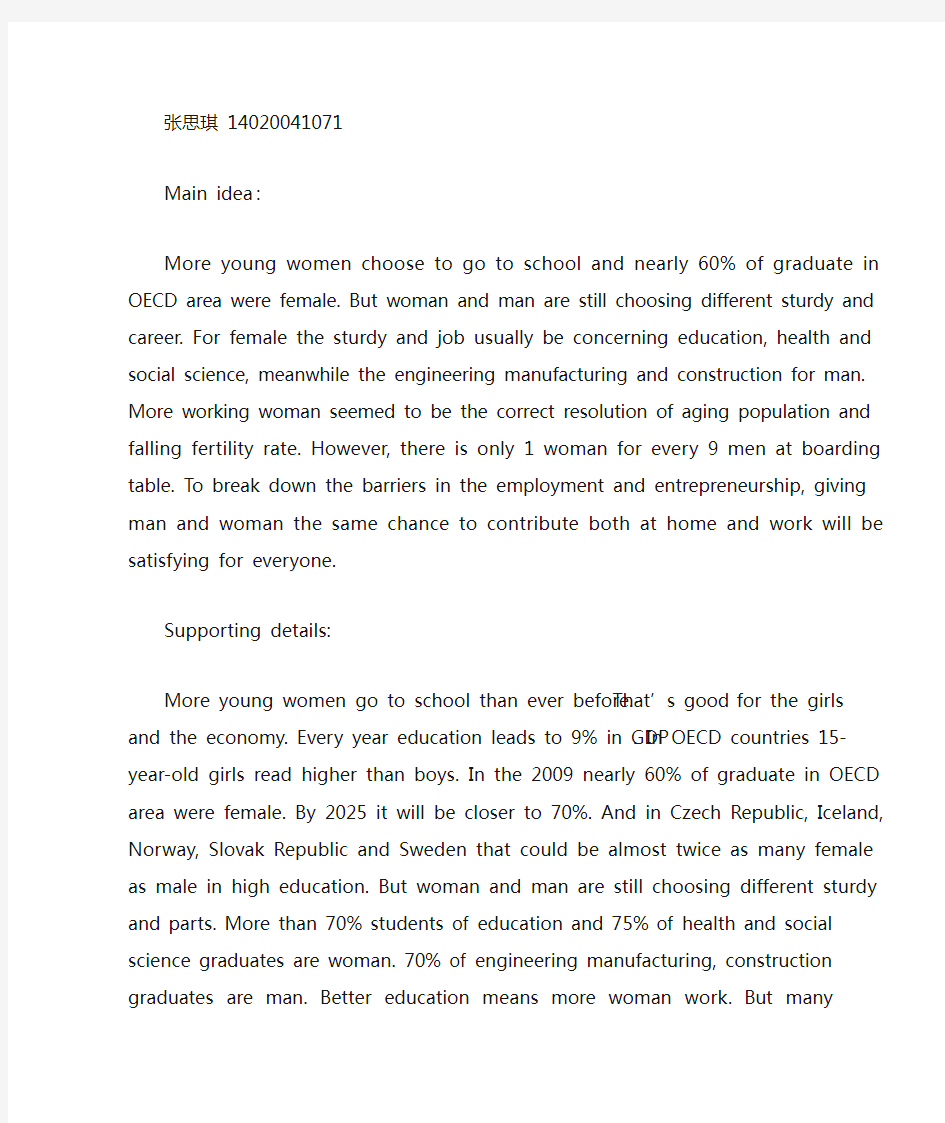Gender Equality


张思琪14020041071
Main idea:
More young women choose to go to school and nearly 60% of graduate in OECD area were female.But woman and man are still choosing different sturdy and career. For female the sturdy and job usually be concerning education, health and social science, meanwhile the engineering manufacturing and construction for man. More working woman seemed to be the correct resolution of aging population and falling fertility rate. However, there is only 1 woman for every 9 men at boarding table. To break down the barriers in the employment and entrepreneurship, giving man and woman the same chance to contribute both at home and work will be satisfying for everyone.
Supporting details:
More young women go to school than ever before. That’s good for the girls and the economy. Every year education leads to 9% in GDP. In OECD countries 15-year-old girls read higherthan boys. In the 2009 nearly 60% of graduate in OECD area were female. By 2025 it will be closer to 70%. And in Czech Republic, Iceland, Norway, Slovak Republic and Sweden that could be almost twice as many female as male in high education. But woman and man are still choosing different sturdy and parts. More than 70% students of education and 75% of health and social science graduates are woman. 70% of engineering manufacturing, construction graduates are man. Better education means more woman work. But many countries are facing the double challenge of aging population and falling fertility rate. The challenge is ensuring the more woman work and those who wants to can go full time. That were required better child care and flexible work educations and those pay-slips are smaller for women on average 16% and gap risen to 21%. Thisglassin the board room.There is only 1 woman for every 9 men. That drop into less than 5% in Germany, Japan and Netherlands. Education is a good start but what about employment and entrepreneurship. The next step must to break down the barriers in the job market, giving man and woman the same chance both at home and work will both across and well-being for everyone.
My opinions:
More young women go to school than ever before. That’s good for the girls and the economy. Every extra year education leads to an average increase over around 9% in GDP per capita. In OECD countries 15-year-old girls read at fullschool year higherthan boys. At anniversary level in the 2009, nearly 60% of graduates in OECD area were female. If that trend continues, by 2025 it will be closer to 70%. And in Czech Republic, Iceland, Norway, Slovak Republic and Sweden that could be almost twice as many female students as male in high education. But woman and man are still choosing different sturdy and career parts. More than 70% university students aimed at education and 75% of health and social science graduates are woman. Also70% of engineering manufacturing, construction graduates are man. Better education means more woman work. But many countries are facing the double challenge of aging population and falling fertility rate. The challenge is ensuring the more woman work and those who wants to can go full time. That were required better child care and flexible work conditions. And those pay-slips are smaller for women than for man on average 16% smaller and gap rises to 21% among top .This seeminglyextend in the board room on average across listed companies in OECD, there is only 1 woman for every 9 menat boarding table.In Norway 40% of board members are women.As a result of the Monday trade court introduced in 2006.In Sweden, France, and Finland between 15% and 20% of board members are women. That drop into less than 5% in Germany, Japan and Netherlands. Education is a good start but what about employment and entrepreneurship. The next step must tobreak downthe barriers in the job market, giving man and woman the same chance to contribute both at home and work will both across and well-being for everyone.
张思琪14020041071
